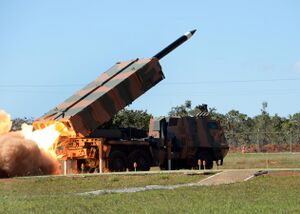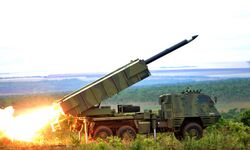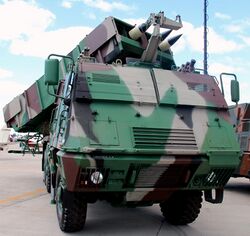Engineering:Astros II MLRS
| ASTROS II Multiple Launch Rocket System (MLRS) | |
|---|---|
 ASTROS II MK6 Brazilian Army | |
| Type | Rocket artillery |
| Place of origin | Brazil |
| Service history | |
| In service | Since 1983 |
| Wars | Iran–Iraq War Gulf War Angolan Civil War Yemeni Civil War (2015–present) Military Intervention in Yemen |
| Production history | |
| Manufacturer | Avibras |
| No. built | 270+ |
| Specifications | |
| Mass | 10,000 kg (22,046 lbs)[1] |
| Length | 7 m (20 ft) |
| Width | 2.9 m (9 ft 6 in) |
| Height | 2.6 m (8 ft 6 in) |
| Crew | 3 |
| Cartridge | Rocket length: 4.20 m (13 ft 9 in)[2] Rocket weight: 152 kg (335 lb)[2] |
| Calibre | 450mm (7.08in)[2] |
| Maximum firing range | 30km(SS-30) to 300km(AV-TM 300)[2] |
Main armament | Universal Multiple Launcher Module 127mm – 450mm |
Secondary armament | 1 × 12.7 mm M2 Browning machine gun[1] |
| Engine | Mercedes OM422 8-cylinder diesel 280 hp (209 kW)[1] |
| Suspension | 6×6 |
Operational range | 480 km (298 mi) |
| Speed | 90 Km/h (56 mph) |
ASTROS II (Artillery Saturation Rocket System) is a self-propelled multiple rocket launcher produced in Brazil by the Avibras company. It features modular design and employs rockets with calibers ranging from 127 mm to 450 mm ( 5-17.72 inches). It was developed on the basis of a Tectran VBT-2028 6×6 all-terrain vehicle for enhanced mobility based on Mercedes-Benz 2028 truck chassis.[3]
Overview
A full ASTROS system includes 1 wheeled 4×4 Battalion level Command Vehicle (AV-VCC), which commands 3 batteries, and a series of 4x4 and 6×6 wheeled vehicles.[3] Each battery consists of:
- 1 wheeled 4×4 Battery-level Command vehicle (AV-PCC)
- 1 wheeled 6x6 Radar Fire Control vehicle (AV-UCF)
- 6 wheeled 6x6 Universal Multiple Rocket Launchers vehicle (AV-LMU)
- 6 wheeled 6x6 Ammunition Resupply vehicles (AV-RMD)
- 1 wheeled 6x6 Field repair/workshop vehicle (AV-OFVE)
- 1 wheeled 4×4 Mobile Weather Station vehicle(AV-MET).
In the older version of the system, the fire control vehicle were listed as optional vehicle in a battery. The command vehicles and weather stations are recent additions, designed to improve overall system performance on newer versions. All vehicles are transportable in a C-130 Hercules.[3] The launcher is capable of firing rockets of different calibers armed with a range of warheads.[4]
Each rocket resupply truck carries up to two complete reloads.
Service history

The ASTROS II artillery system entered service with the Brazilian Army in 1983. The system is battle proven, having been used in action by the Iraqi Army in the Gulf Wars.
In the 1980s, Avibrás sold an estimated 66 Astros II artillery systems to Iraq. Iraq also built the Sajeel-60 which is a license-built version of the Brazilian SS-60. Sixty Astros II were sold to Saudi Arabia[5] and an unspecified number sold to Bahrain and Qatar. Total sales of the Astros II between 1982 and 1987 reached US$1 billion. This fact made the Astros II multiple rocket launcher the most profitable weapon produced by Avibrás.[6]
In the 1980s and early 1990s, Avibrás worked almost exclusively with the manufacturing of rockets and multiple-launch rocket systems (MLRS), such as the Astros II, in addition to developing antitank and antiship missiles. At its peak, Avibrás employed 6,000 people; later it would be reduced to 900 people in the early 1990s as the arms industry demand fell. Even so, in the first Gulf War in 1991, the Astros II was successfully used by Saudi Arabia against Iraq.[7] Years earlier, the Astros II system helped Angola to defeat the UNITA.
New generation


The next step is an ambitious program, the ASTROS 2020 (MK6), based on a 6x6 wheeled chassis.[8] Being a new concept, it will require an estimated investment of R$1.2 billion, of which about US$210 million will be invested solely in development. It will be integrated with the cruise missile AVMT-300 with 300-km range during the stage of testing and certification. It is said that the venture will, for example, enable the Army to integrate the Astros with defense anti-aircraft guns, paving the way for the utilization of common platforms, trucks, parts of electronic sensors and command vehicles.[9][10] The new MK6 system will use Tatra Trucks’ T815-790R39 6×6 and T815-7A0R59 4×4 trucks instead of the original Mercedes-Benz 2028A 6x6 truck. ASTROS 2020 offers several basic improvements including an improved armored cabin, modern digital communications and navigation systems, and a new tracking radar that replaces the AV-UCF’s Contraves Fieldguard system.[3] The new tracking radar used by MK6 AV-UCF was latter revealed to be the Fieldguard 3 Military Measurement System from Rheinmetall Air Defence.[11] The Astros 2020 will also be equipped with a 180 mm GPS-guided rocket called the SS-AV-40G with a range of 40 km (25 mi) and SS-150 newly developed rockets with a claimed maximum range of 150 km. Four of them are carried.[12] 36 Astros 2020 systems are to be acquired.[13]
Rocket variants

- SS-09TS – fires 70 mm rockets – Loads 40
- SS-30 – fires 127 mm rockets – Loads 32
- SS-40 – fires 180 mm rockets – Loads 16
- SS-AV-40G – fires 180 mm rockets – Loads 16
- SS-60 – fires 300 mm rockets – Loads 4
- SS-80 – fires 300 mm rockets – Loads 4
- SS-150 – fires 450 mm rockets – Loads 4
- AV-TM 300 - fires 450 mm Cruise missile – Loads 2
- FOG MPM - Fiber Optic Guided Multi-Purpose Missile – Anti-tank, anti-fortification and anti-helicopter missile
- FOG MLM - fiber Optics Guided multi-purpose missile
Specifications

- Range in indirect fire mode[14] (first figure is minimum range):
- SS-09TS: 4–10 km
- SS-30: 9–30 km
- SS-40: 15–40 km
- SS-AV-40G: 15–40 km
- SS-60: 20–60 km
- SS-80: 22–90 km
- SS-150: 29–150 km
- AV-TM 300: 30–300 km
- FOG MPM: 5–60 km
- Armour: classified. Probably light composite to give protection against small-arms fire.
- Armament: one battery of 2, 4, 16 or 32 rocket-launcher tubes
- Performance:
- fording 1.1 m
- vertical obstacle 1 m
- trench 2.29 m
- Ammunition Type: High explosive (HE) with multiple warhead
Operators

Current operators
 Brazil
Brazil
- Brazilian Army: 38 Astros II MK3, 18 Astros II MK3M and 22 Astros II MK6
- Brazilian Marine Corps: 6 Astros II MK6
 Malaysian Army: 54 Astros II [4][15][16]
Malaysian Army: 54 Astros II [4][15][16] Indonesian Army: 63 Astros Il MK6 (1st batch of 36 ordered in 2012 & 2nd batch of 27 delivered in 2020).[17]
Indonesian Army: 63 Astros Il MK6 (1st batch of 36 ordered in 2012 & 2nd batch of 27 delivered in 2020).[17] Iraq: 66 Astros II[6] (also built under license as the Sajil-60). Only with rockets of shorter range SS-40 and SS-60.
Iraq: 66 Astros II[6] (also built under license as the Sajil-60). Only with rockets of shorter range SS-40 and SS-60. Saudi Arabia: 76 Astros II[5]
Saudi Arabia: 76 Astros II[5] Libya: It is known that the country was one of the three largest buyers of the system, alongside Iraq and Saudi Arabia, having invested US $ 2 million to purchase Astros. However, the exact number is undefined.
Libya: It is known that the country was one of the three largest buyers of the system, alongside Iraq and Saudi Arabia, having invested US $ 2 million to purchase Astros. However, the exact number is undefined. Bahrain
Bahrain Qatar
Qatar Angola[18]
Angola[18]
See also
- HIMARS
- BM-21
- RM-70
- T-122 Sakarya
- 9A52-4 Tornado
- Fajr-5
- TOROS
- Falaq-2
- Pinaka multi-barrel rocket launcher
References
- ↑ 1.0 1.1 1.2 "ASTROS-II – Avibrás / Brasil". http://www.areamilitar.net/DIRECTORIO/TER.aspx?nn=23&p=15.
- ↑ 2.0 2.1 2.2 2.3 Hogg, Ian. Twentieth-Century Artillery. New York: Barnes & Noble Books, 2000. ISBN 0-7607-1994-2 Pg.304
- ↑ 3.0 3.1 3.2 3.3 Staff, Defense Industry Daily. "ASTROS 2020 MLRS: Brazils Industrial Investment in Precision Strike". http://www.defenseindustrydaily.com/astros-2020-brazil-moves-to-revive-avibras-07069/.
- ↑ 4.0 4.1 "Astros II Artillery Saturation Rocket System". http://www.army-technology.com/projects/astros/.
- ↑ 5.0 5.1 Servaes, Army Recognition Alain. "Military army ground forces equipment Saudi Arabian Army Forces Saudi Arabia Equipements militaires armée forces terrestres Arabie Saoudite". http://www.armyrecognition.com/moyen_orient/Saudi_Arabia/Index_Saudi_Arabia_army_ground_foces_military_equipment.htm.
- ↑ 6.0 6.1 "Export Controls In Brazil". http://www.uga.edu/cits/documents/pdf/BrazilXC.pdf.
- ↑ "BBC News - BUSINESS - Cruise missiles 'Made in Brazil'". http://news.bbc.co.uk/1/hi/business/1525374.stm.
- ↑ "Archived copy". http://www.military-today.com/artillery/astros_iii.htm.
- ↑ "Governo se torna sócio da Avibrás Aeroespecial". http://economia.estadao.com.br/noticias/not_6638.htm.
- ↑ "ANA株主優待券は安く買おう!便利な株主優待券の使い方!". http://www.politicaexterna.com/archives/8903#axzz0raOz9k4R%7CGoverno.
- ↑ "Rheinmetall Defence - Archive 2018 Follow-up order from Brazil for Rheinmetall’s Fieldguard 3 measurement system". https://www.rheinmetall-defence.com/en/rheinmetall_defence/public_relations/news/archiv/2018/aktuellesdetailansicht_8_20160.php.
- ↑ "Archived copy". http://www.military-today.com/artillery/astros_iii.htm.
- ↑ Brazilian army will continue to upgrade Astros rocket launchers – Armyrecognition.com, December 29, 2012
- ↑ "ASTROS (Artillery SaTuration ROcket System)". http://www.fas.org/man/dod-101/sys/land/row/astros.htm.
- ↑ "Kosmo! Online - Negara". http://www.kosmo.com.my/kosmo/content.asp?y=2012&dt=0307&pub=Kosmo&sec=Negara&pg=ne_09.htm.
- ↑ Mahadzir, Dzirhan (2019-04-05). "Malaysia's Defence Doldrums" (in en-US). https://asianmilitaryreview.com/2019/04/malaysias-defence-doldrums/.
- ↑ "Indonesian army takes delivery of MLRS Avibras Astros II Mk 6 from Brazil | June 2020 News Defense Global Security army industry | Defense Security global news industry army 2020 | Archive News year". https://www.armyrecognition.com/june_2020_news_defense_global_security_army_industry/indonesian_army_takes_delivery_of_mlrs_avibras_astros_ii_mk_6_from_brazil.html.
- ↑ "Brazil releases funds to develop surface to surface missile system for the Army". Merco Press. 31 August 2011. http://en.mercopress.com/2011/08/31/brazil-releases-funds-to-develop-surface-to-surface-missile-system-for-the-army.
External links
